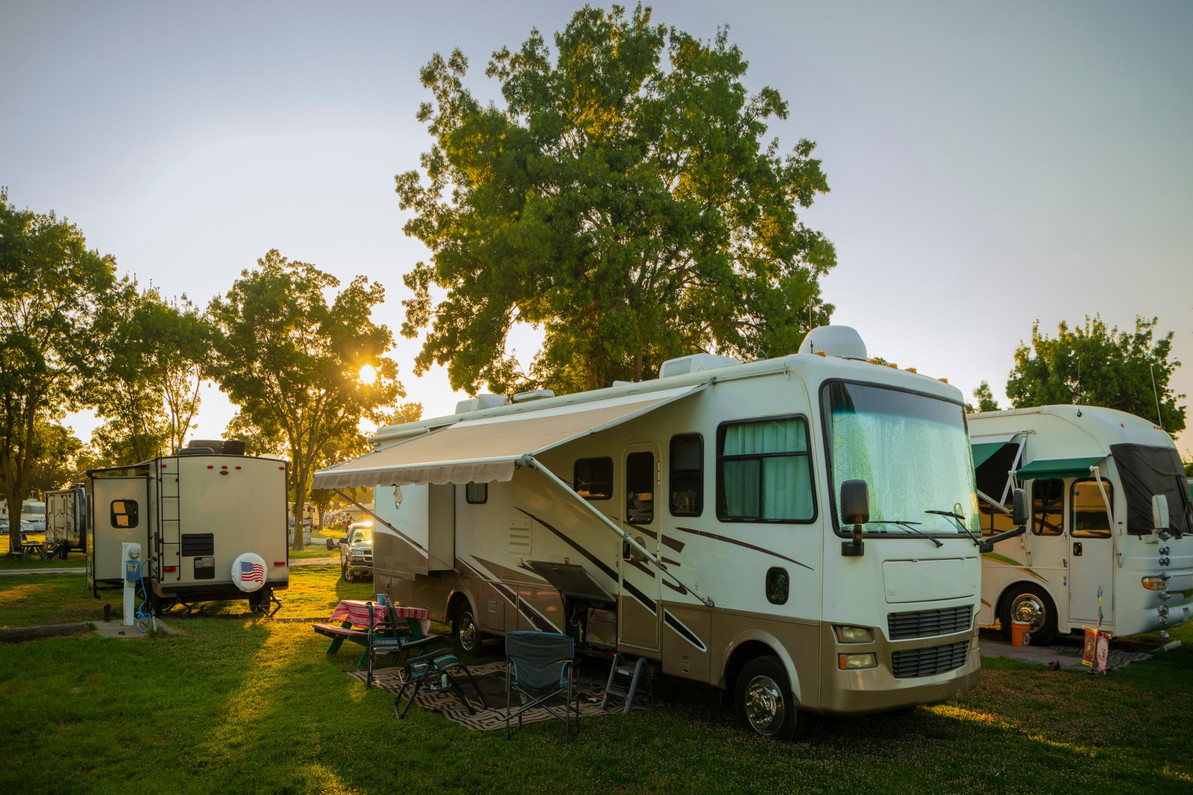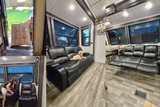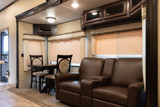Looking at The History of Recreational Vehicles | Recpro
The Evolution of the Recreational Vehicle
Americans have always entertained a long and storied love affair with travel, technically spanning back to the Louisiana Purchase and subsequent western expansion. Though the outward appearance of the covered wagon trains, which bore hopeful settlers on their long & arduous journeys across the plains, bear little resemblance to the RV's we know and love today, the "travelin' itch" has never left our zeitgeist.
The US's first camping vehicle was patented in 1889 by Alonzo J. McMaster. As this camping carriage predates the first American production car (the Model T) by 19 years, McMasters' "Camping Vehicle" would have been a horse-drawn affair. The carriage was equipped with all the amenities required to function as a bedroom, sitting room, or kitchen.
You can check out the layout of McMasters' original RV Patent here, as well as an updated design here.
Shifting From Horses to Automobiles
The horse-drawn RV wouldn't see too much competition for a brief stint, that is, until the paradigm shifted rather drastically with the introduction of the automobile in the 1910s.
It is fairly well known that Hank Ford pioneered the assembly line framework, breaking complex tasks down into simple repetitive steps. It was this innovation that enabled the price of automobiles to settle down to a level where the middle and working class could afford them. Instead of being a luxury item only affordable to the upper class, automobiles were rather suddenly within reach of the middle and working classes. This caused the number of both production and DIY motor campers to scale up in relation to the massive influx of cars hitting the roads.
Due to the anemic and inefficient nature of early internal combustion engines, coupled with their rudimentary suspension geometry and powertrain components... Let's just say that early cars had a towing ability that reflected their relative novelty. Cars were still essentially in the beta test stage at this point and still shared the mostly unpaved road system with the good ol' horse and buggy, with laws that decidedly still favored the latter.
Towing Capacity: 1900's vs. 2020's
Just for some context, in this day and age, our full-size pickup trucks can comfortably haul up to around 7 tons (14000 lbs). Heavy Duty or Dually trucks push that number up to 10.5 tons (21,000 lbs) or higher. The Model T and Model A would have had a towing capacity upper limit of around ¼ ton (500 lbs).
With these stats in mind, it's easy to infer that from very early on in the history of RVs, there has been a need for lightweight and robust construction methods & materials. Though our contemporary individual towing capacity has increased exponentially, these aforementioned factors continue to shape the direction of the RV industry to this day. Weight savings are still at the forefront of modern-day RV manufacturers' and owners' minds.

What Draws People to the RV Experience?
Let's take a look at a different through-line, a different concept that has gone hand-in-hand with Recreational Vehicles since their inception. I am speaking to the spirit of adventure and exploration. RV's tap into a deep and abiding desire to explore and experience the world around us. It is not the same experience that one gets while traveling via airplane; you do not magically appear at your destination, disheveled, smelly, and feeling like you've just teleported... albeit incredibly slowly.
No, traveling via road is a continuous conscious experience; there is no "feeling like you've teleported" to your destination, as you have been in close proximity with the ground which you have covered, seeing and experiencing all of the minutiae that life has to offer around you.
There's no stopping the train or plane to get lunch at a local hole-in-the-wall, stop for a hike, or purchase supplies and support a small business and local economy. You get the gist. It is simply a different way to experience travel. It is not as much about arriving at the destination but enjoying the journey.
Notable RV Enthusiasts
On the topic of exploratory spirit, in 1915, there was a group of notable… let's call them camping enthusiasts. These fellas were rather well known for varying reasons, but what brought them together was their mutual love of exploration.
The group consisted of Henry Ford, Harvey Firestone, Thomas Edison, and John Burroughs. These men called themselves the Four Vagabonds and organized yearly & increasingly elaborate camping trips over the next 9 years. These guys were the original overland enthusiasts.
Every summer from 1915-24, they would venture out with custom-made camper vehicles fresh out of the Ford plant, and an entourage of support vehicles, reportedly up to 50 vehicles, accompanied them. These caravans increased in size every year until the campers' fame drew too much attention for them to continue with their trips.
Here is a photo album showing the group in their heyday. There is also a book on the topic: The Vagabonds: The Story of Henry Ford and Thomas Edison's Ten-Year Road Trip.
Bumpy Roads Ahead
 This brings us to the 1920s, which places us on the cusp of the Great Depression. RVs technically became more popular during this period, but more so out of financial desperation and a lack of immobile housing than anything else. Undoubtedly some innovation took place during this period, but for the most part, people living out of cars and trailers during this time were doing it out of necessity rather than as a form of vacation.
This brings us to the 1920s, which places us on the cusp of the Great Depression. RVs technically became more popular during this period, but more so out of financial desperation and a lack of immobile housing than anything else. Undoubtedly some innovation took place during this period, but for the most part, people living out of cars and trailers during this time were doing it out of necessity rather than as a form of vacation.
It was in the late 1920s and early 1930's that some significant strides were made in the RV industry, one in the form of "Covered Wagons." This design was the brainchild of Arthur Sherman, as a result of him and his family having a run-in with some severe weather in their newly purchased and "allegedly" waterproof trailer. Sherman's new design utilized solid masonite walls, which competitors lacked, and was larger than most other trailers at the time. He called it the Covered Wagon and displayed it at the 1930 Detroit Auto Show, asking the price of $400.
Zeroing in on a Standard Design and Footprint
In 1929, Airstream started to build trailers, with the first one being built around a Model T; and settling on their wonderfully aerodynamic and classic teardrop body styling by 1932. Their price point was from $500-$1100, though both competitors took a while to catch on, what with the Great Depression raging on.
By 1936, the Covered Wagon design had dominated the American trailer industry, signaling the end of the road for soft-top trailers. The company was originally based in Mount Clemens, Michigan, but production moved to Elkhart, Indiana, in the 1950s. Elkhart is, to this day, the largest RV manufacturing center in the world, with ~80% of all RVs being manufactured there.
Let us know in the comments if you have any memories of these antique RVs or would like to see a specific one featured in a future blog. If you found this topic interesting, make sure to check back for Part 2, where we will cover RV history from the 1940s onward.
Recent Posts
-
Traveling to the RV Hall of Fame in Elkhart, IN
If you are traveling to Elkhart, IN to see the RV Hall of Fame, getting off the toll road at exit 96 …Nov 14, 2025 -
Best RV Air Conditioners of 2025: An Expert Guide From RecPro
Quick Answers Best overall RV air conditioner: RecPro 15K Quiet AC with Heat Pump (RP-AC3800) Best f …Oct 29, 2025 -
The Nuclear Nomads Expand Sofa with New Recliner Section Install
The Nuclear Nomads are a full time RV family living in south Florida. Andi and Joey value quality ti …Oct 24, 2025 -
Trailer Wiring Guide: How to Wire Your Trailer for Safety and Efficiency
Table of Contents 1. Common Types of Trailer Connectors 2. Trailer Wiring Diagrams: Color Codes and …Aug 20, 2024 -
How to Keep Your Pets Safe While Camping
RVing and camping are a great getaway from the hustle and bustle of work and the city and the day-to …Jul 02, 2024 -
Why Replace Your RV Furniture?
You may wonder when is the best time to replace your RV furniture. There is no one right answer to t …May 20, 2024







